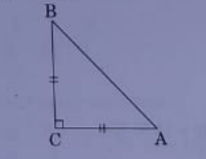Simplify the expression: (ab + bc)^2– 2ab²c Solution in Bengali
The man can be one stap away from the statting point if (i) either he is one stgep aheld or (ii) one step behind the starting point. Now if at the end of the 11 steps, the man is one step ahead of the starting point, then our of 11 steps, he must have taken six forward steps and five backward steps. The probability of this event is
11C6×(0.4)6×(0.4)5=462×(0.6)6×(0.6)5
Again if at the end of the 11 steps, then man is one step behind the staring point, then out of 11 steps, he must have taken six backward steps and five forward steps, The probability of this event is
11C6×(0.6)6×(0.4)5=462×(0.6)6×(0.4)5
Since the events (i) and (ii) are mutually exclusive, the required probability that one of these events hapen is
[462×(0.4)6×(0.6)5]+[462×(0.6)6×(0.4)5]
=462×(0.4)5×(04)5(0.4+0.6)=462×(0.4×0.6)5=462(0.24)5
Topper's Solved these Questions
- BOOK - CENGAGE PUBLICATIONCHAPTER - PROBABILITY IIEXERCISE - CONCEPT APPCICATION EXERCISE 14.15videos
PROBABILITY II
- BOOK - CENGAGE PUBLICATIONCHAPTER - PROBABILITY IIEXERCISE - CONCEPT APPCICATION EXERCISE 14.23videos
PROBABILITY II
- BOOK - CENGAGE PUBLICATIONCHAPTER - PROBABILITY IIEXERCISE - MULTIPLE CORRECT ANSWER TYPE6videos
PROBABILITY II
- BOOK - CENGAGE PUBLICATIONCHAPTER - PROBABILITY I EXERCISE - JEE Advanced7videos
PROBABILITY I
- BOOK - CENGAGE PUBLICATIONCHAPTER - PROGRESSION AND SERIESEXERCISE - ARCHIVES (NUMERICAL VALUE TYPE )8videos
PROGRESSION AND SERIES
Similar Questions
Three coins are tossed. If one of them shows tail, then find the probability that all three coins show tail.
01:23View SolutionA bag contains 5 white and 3 black balls. Four balls are successively drawn out without replacement. What is the probability that they are alternately of different colours?
02:00View SolutionLet EandF be two independent events. The probability that exactly one of them occurs is 1125 and the probability if none of them occurring is 225. If P(T) denotes the probability of occurrence of the event T, then (a) P(E)=45,P(F)=35 (b) P(E)=15,P(F)=25 (c) P(E)=25,P(F)=15 (d) P(E)=35,P(F)=45
02:48View SolutionLet ω be a complex cube root unity with ω≠1. A fair die is thrown three times. If r1,r2andr3 are the numbers obtained on the die, then the probability that ωr1+ωr2+ωr3=0 is 1/18 b. 1/9 c. 2/9 d. 1/36
03:01View SolutionLet Sk,k=1,2,….100 denote the sum of the infinite geometric series whose first term is k−1K! and the common
ration is 1k then the value of (100)2100!+Σ100k=1|(k^2-3k+1)S_k| is ____________02:22View Solutionসরল করো : (a-b)+(b-c)+(c-a)
01:23View Solutionসরল করো : a(b-c)+b(c-a)+c(a-b)
04:37View Solutionসরল করো : 6a−2b−ab−(3a+b−ab)+2ab−b+a
01:52View Solutionin figure, ABC is an isosceles traingle, right angled at C. therefore

a) AB2=2AC2
b) BC2=2AB2
c) AC2=2AB2
d) AB2=4AC2View SolutionSimplify the following: 6a-2b-ab-(3a+b-ab)+2ab-b+a
01:26View SolutionSimplify (ab+bc)2−2ab2c
01:51View Solutionসরল করো : 6a−2b−ab−(3a+b−ab)+2ab−b+a
03:18View Solutionসরল করো : a(b-c)+b(c-a)+c(a-b)
02:34View SolutionIf A = (1, 2, 3), B = (2, 3, 4) and AB is produced upto C such that 2AB = BC, then C =
01:31View SolutionSimplify:
(ab+bc)2−2ab2c02:25View Solution

